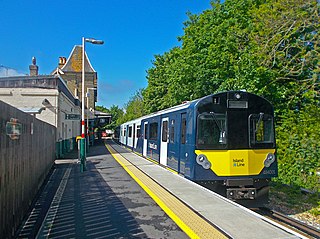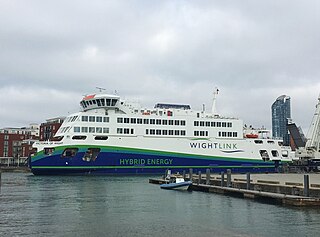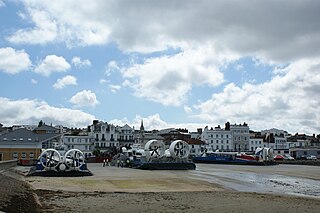Background and construction
Following the Second World War, Southern Railway, which operated passenger and vehicle ferry services to the Isle of Wight, decided to supplement and replace the existing coal burning paddle steamers that operated on the Portsmouth to Ryde route with modern twin screw diesel powered vessels.
Initial plans, incorrectly based on a predicted downward trend in passenger numbers, were to order the construction of two such vessels. These were to be the identical ships Southsea and Brading built by William Denny and Brothers in Dumbarton on Clydeside. They were launched on 11 March 1948 [2] and went into service with British Railways, Southsea being the first to enter service, on 1 November 1948. One of the existing paddle steamers, Merstone, was replaced (two having been sunk during World War II) and four were retained initially. The two ships were the first on the route to be fitted with radar which quickly proved itself in foggy conditions that had previously left the Isle of Wight cut off from the mainland. [2]
Increasing numbers of passengers quickly led to the order for a third similar ship, Shanklin, in 1951. She entered service as a one-class ship and her two sisters became one-class at the same time. The ships all received a major overhaul in 1967 with an extra passenger deck, as a continuation of the bridge deck, and improved seating and catering facilities. [2]
Brading and Southsea outlasted their newer sister on the Portsmouth to Ryde run, being replaced in 1986 by new catamaran-type ferries, Our Lady Pamela and Our Lady Patricia. Southsea was retained until 1987 as a backup, after which she operated pleasure cruises for two seasons. [2] She was then earmarked for potential preservation, being laid up first at Falmouth and later at Drivers Wharf on the Itchen in Southampton. Ultimately the preservation attempt failed and she was eventually scrapped in 2005 in Esbjerg.

The Island Line is a railway line on the Isle of Wight which runs along the island's east coast and links Ryde Pier Head with Shanklin. Trains connect at Ryde Pier Head with passenger ferries to Portsmouth Harbour, and these ferries in turn connect with the rest of the National Rail network via the Portsmouth Direct Line. The line also connects to the Isle of Wight Steam Railway, a heritage railway, at Smallbrook Junction. For much of its length the line runs alongside the A3055, criss-crossing this road by means of the Ryde Tunnel and bridges at Rowborough, Morton Common, Lake Hill and Littlestairs.

PS Waverley is the last seagoing passenger-carrying paddle steamer in the world. Built in 1946, she sailed from Craigendoran on the Firth of Clyde to Arrochar on Loch Long until 1973. Bought by the Paddle Steamer Preservation Society (PSPS), she has been restored to her 1947 appearance and now operates passenger excursions around the British coast.

Wightlink is a ferry company operating routes across The Solent between Hampshire and the Isle of Wight in the south of England. It operates car ferries between Lymington and Yarmouth, and Portsmouth and Fishbourne and a fast passenger-only catamaran between Portsmouth Harbour and Ryde Pier. It is jointly owned by Basalt Infrastructure Partners and Fiera Infrastructure.

Red Funnel, the trading name of the Southampton Isle of Wight and South of England Royal Mail Steam Packet Company Limited, is a ferry company that carries passengers, vehicles and freight on routes between the English mainland and the Isle of Wight. High-speed foot passenger catamarans, known as Red Jets, run between Southampton and Cowes, while vehicle ferries run between Southampton and East Cowes.

The Isle of Wight Railway was a railway company on the Isle of Wight, United Kingdom; it operated 14 miles of railway line between Ryde and Ventnor. It opened the first section of line from Ryde to Sandown in 1864, later extending to Ventnor in 1866. The Ryde station was at St Johns Road, some distance from the pier where the majority of travellers arrived. A tramway operated on the pier itself, and a street-running tramway later operated from the Pier to St Johns Road. It was not until 1880 that two mainland railways companies jointly extended the railway line to the Pier Head, and IoWR trains ran through, improving the journey arrangements.

PS Lincoln Castle was a coal-fired side-wheel paddle steamer, which ferried passengers across the Humber from the 1941 until 1978. She was the last coal-fired paddle steamer still in regular services in the UK. Later, she served as a pub at Hessle, and then as a restaurant under permanent dock at Alexandra Dock, Grimsby. In September 2010, the Hull Daily Mail reported that she was in an advanced state of demolition, despite the efforts of local people to buy the historic vessel and restore her. On 31 March 2011, the Lincoln Castle Preservation Society were reported to have purchased the broken up parts of the ship for restoration.

Island Harbour Marina, on the Isle of Wight, UK, is a commercial marina on the River Medina in the small hamlet of Binfield. It is located approximately halfway between Cowes and the County Town of Newport. Visiting yachtsmen will find it just past the Folly Inn on the East bank. Being a relatively small marina, it best suits pleasure craft of up to 20 metres in length. The marina accommodates both annual berthholders and short-term visiting craft.

PS Ryde is a paddle steamer that was commissioned and run by Southern Railway as a passenger ferry between mainland England and the Isle of Wight from 1937 to 1969, with an interlude during the Second World War where she served as a minesweeper and then an anti-aircraft ship, seeing action at D-Day. After many years abandoned on moorings at Island Harbour Marina on the River Medina, she was purchased by the PS Ryde Trust in late 2018, with the intention of raising money for her restoration. That project was abandoned in January 2019.

TSMV Shanklin was a passenger ferry that operated between Portsmouth and the Isle of Wight between 1951 and 1980. Renamed Prince Ivanhoe she went on to become a pleasure cruiser in the Bristol Channel but in 1981 sank off the Welsh coast on her first season.

There are currently three different ferry companies that operate vessels carrying passengers and, on certain routes, vehicles across the Solent, the stretch of sea that separates the Isle of Wight from mainland England. These are Wightlink, Red Funnel and Hovertravel.

HSC FastCat Shanklin is a high speed catamaran ferry which operated between the Isle of Wight and mainland England. She operated on the Wightlink Ryde Pier to Portsmouth route from 2000 to 2009 along with her sister ship HSC FastCat Ryde. Prior to working for Wightlink, the ship worked in Singapore and was named Water Jet 2. In 1999, the year before it was sold to Wightlink, its name was changed to Supercat 18.

HSC Wight Ryder I is one of two high-speed passenger catamarans operated by Wightlink on the Ryde to Portsmouth ferry route.
The River Dart Steamboat Co Ltd (RDSC) and its predecessors, the Dartmouth Steam Packet Company and the Dartmouth and Torbay Steam Packet Company, were the major ferry and excursion boat operators on the River Dart in South Devon for 120 years, until the company's demise in 1976. The company was famous for its distinctive paddle steamers, which were a familiar sight on the river until the late 1960s.
Duchess of Norfolk was a 381 GRT paddle steamer built in 1911 for the London, Brighton and South Coast Railway and London and South Western Railway, who operated a joint service to the Isle of Wight. She was requisitioned by the Royal Navy for use as minesweeper HMS Duchess of Norfolk during the First World War, returning to her owners after the war ended. She passed to the Southern Railway on 1 January 1923.
The Stokes Bay line was a short railway branch line in Hampshire, England, near Gosport. Associated with a new pier, it was intended to give direct and easy access from trains to steamers to the Isle of Wight in comparison to the conventional route through Portsmouth, which required a road transport connection though the town. Railway operation to the Stokes Bay pier started in 1863.

This article describes the shipping services of the London and South Western Railway and the vessels employed.
PS Southsea was a passenger vessel built for the Southern Railway in 1930. Requisitioned by the Royal Navy for war service, she was wrecked after hitting a naval mine in 1941.

PS Whippingham was a passenger paddle steamer built for the Southern Railway in 1930 for the ferry route to the Isle of Wight. After distinguished war service, she returned to ferry work until she was scrapped in 1963.

PS Sandown was a passenger vessel built for the Southern Railway in 1934 and later served with distinction in the Royal Navy during the Second World War.

TSMV Brading was a passenger ferry that operated between Portsmouth and the Isle of Wight between 1948 and 1986.
















